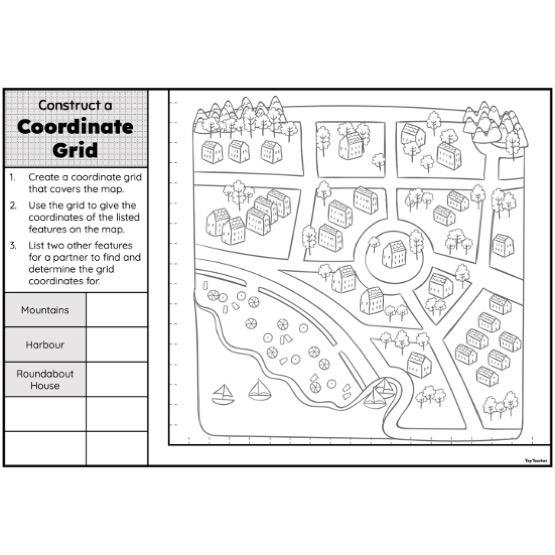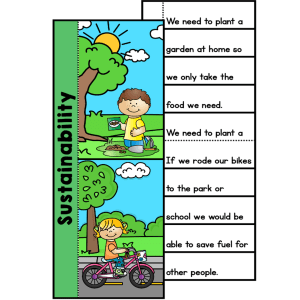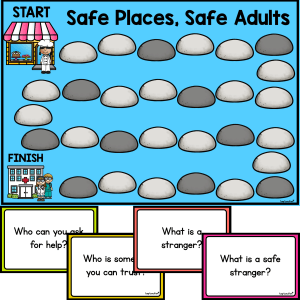Construct a Coordinate Grid: Town Mapping Worksheet

Description
Bring mapping to life with the hands-on Construct a Coordinate Grid: Town Mapping Worksheet. This interactive task helps students build their understanding of coordinate grids by constructing one themselves—right on top of a town map! With ruler in hand, they’ll determine a scale, draw axes, and label coordinates before using the grid to pinpoint locations within the town.
Ideal for developing skills in measurement, geometry and spatial awareness, this activity puts students in the role of a cartographer. Not only do they practise placing a grid, but they also interpret coordinates, identify town features, and even challenge a peer to locate items they’ve added. It’s a rich and purposeful way to reinforce coordinate systems while connecting to real-world applications.
The resource includes three versions to support different levels of scaffolding: a fully blank map, a notched map to guide grid spacing, and a pre-gridded version for a ready-to-go option. All require students to label the axes, encouraging ownership and deepened understanding of the structure of coordinate systems.
Key Learning Outcomes:
- ✅ Construct a coordinate grid on a map using appropriate scale and spacing
- ✅ Label grid axes with consistent and logical numbering
- ✅ Use coordinates to locate and describe features on a map
- ✅ Apply spatial reasoning to map and interpret data visually
- ✅ Engage in peer-based learning through feature identification tasks
What’s Included:
- Blank town map worksheet for full grid construction
- Map with notched edges to support 1 cm scale alignment
- Pre-gridded 1 cm map for quick-start or differentiation
Materials Needed:
- Printed worksheet (select preferred version based on student needs)
- Ruler and pencil for grid construction
- Coloured pencils for identifying and labelling town features
- Eraser for adjustment or correction as needed
How to Use:
- Introduce the concept of coordinate grids and explain the task.
- Students choose a version of the map based on their level or your guidance.
- Using a ruler, they draw horizontal and vertical lines to create the grid.
- Students number each axis, then find and list the coordinates of specific town features.
- As a challenge, they add two more features for a peer to locate using coordinate clues.
Ideas for Classroom Use:
- 💡 Use during your geometry or location unit as a consolidation activity
- 💡 Incorporate into a cartography-themed or real-world mapping project
- 💡 Offer different versions for tiered differentiation or as early-finisher options
- 💡 Add a creative writing extension where students describe a day in the town they mapped
- 💡 Link with historical studies by mapping ancient or fictional towns using the same structure
Top Teacher Tips:
- 💛 Model how to use a ruler and set scale before students begin drawing
- 💛 Emphasise consistency in axis labelling—use even spacing and clear numbers
- 💛 Consider printing on A3 paper for extra space and visual clarity
- 💛 Laminate the pre-gridded version to use as a reusable mapping mat with dry-erase markers
- 💛 Pair students for the peer challenge to support vocabulary and collaborative discussion
Construct a Coordinate Grid: Town Mapping Worksheet is a versatile and practical resource that empowers students to take ownership of their learning by designing and interpreting their own coordinate systems. It’s an ideal blend of hands-on maths and real-world relevance.
Additional information
| Number of Pages | 3 |
|---|---|
| File Format | |
| Australian Curriculum Code | AC9M5SP02 |
Australian Curriculum V9
F - 6
Lorem ipsum dolor sit amet, consectetur adipiscing elit.
Lorem ipsum dolor sit amet, consectetur adipiscing elit.
Lorem ipsum/ Lorem ipsum/ Lorem ipsum
Lorem ipsum dolor sit amet, consectetur adipiscing elit.
Lorem ipsum dolor sit amet, consectetur adipiscing elit.
Lorem ipsum/ Lorem ipsum/ Lorem ipsum
Lorem ipsum dolor sit amet, consectetur adipiscing elit.
Lorem ipsum dolor sit amet, consectetur adipiscing elit.
Lorem ipsum/ Lorem ipsum/ Lorem ipsum
Lorem ipsum dolor sit amet, consectetur adipiscing elit.
Lorem ipsum dolor sit amet, consectetur adipiscing elit.
Lorem ipsum/ Lorem ipsum/ Lorem ipsum
Lorem ipsum dolor sit amet, consectetur adipiscing elit.
Lorem ipsum dolor sit amet, consectetur adipiscing elit.
Lorem ipsum/ Lorem ipsum/ Lorem ipsum





